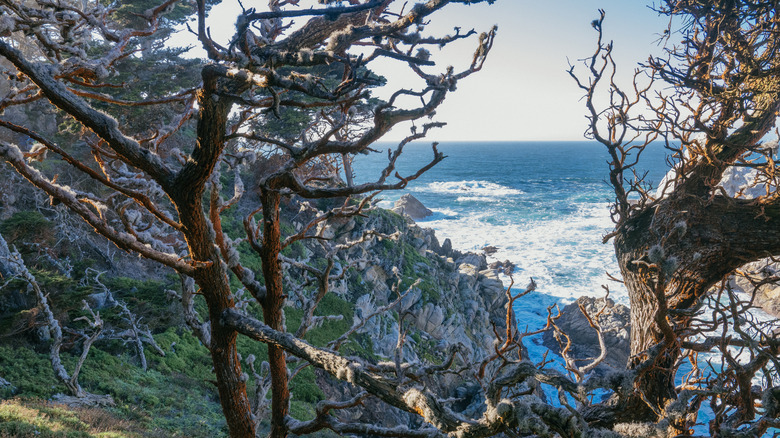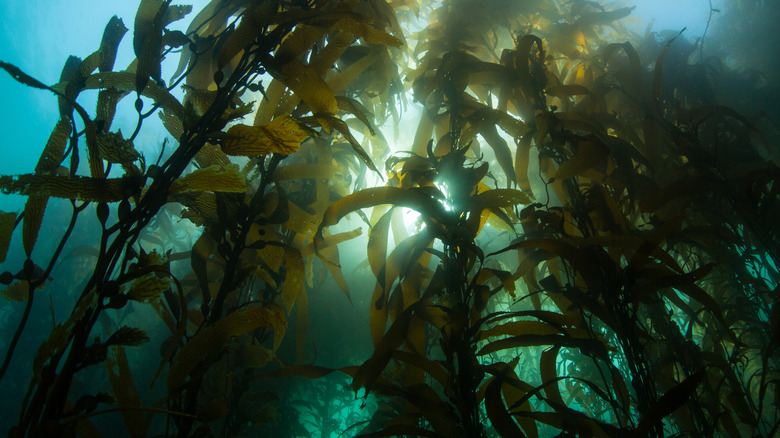The 'Crown Jewel Of California's State Park System' Is Worth Adding To Your Bucket List
California is a standout state in many ways. Not only is it the most populous state, but it also has the largest economy in the country and the 4th largest in the entire world. While these are all noteworthy distinctions, California has another unexpected claim to fame. It's home to the greatest number of state parks, at 280 and counting.
One of the best things about the Golden State is its geographical diversity. Its landscape includes sparkling beaches — such as the gorgeous and uncrowded Seal Beach — misty forests, active volcanoes, vast stretches of desert, and a breathtakingly beautiful island akin to the Amalfi Coast, to name a few. The state's incredible biodiversity is on display at its state parks, and while a visit to any of them is likely to scratch your itch for outdoor bliss, one park stands out from the rest: Point Lobos State Natural Reserve.
Often referred to as "the crown jewel" of the California State Park system, Point Lobos State Natural Reserve sits on a stretch of coastline between Big Sur and Monterey. The park is a uniquely beautiful spot, with stands of cypress trees overlooking the surging blue waters of the Pacific Ocean. Point Lobos also features remarkable rock formations, and is one of the best places in California to spot marine wildlife, such as gray whales passing by during their bi-annual migrations. The park attracts scuba divers from all over who come to witness the brilliant underwater world protected within the boundaries of the park.
The history and scenery of Point Lobos State Natural Reserve
Originally inhabited by the Indigenous Rumsen people of the Ohlone tribe for some 2,500 years, Point Lobos has a storied past. Over the past three centuries, the area has been home to Spanish ranchers, Japanese and Chinese fishermen, as well as Portuguese whalers, whose whaling cabin — now a small museum — stands to this day. This remarkable piece of land was eventually acquired by the state of California in 1933, and today ranks among the most beautiful reserves in the state park system.
Point Lobos State Natural Reserve only occupies 400 acres of land, though the underwater portion encompasses some 9,907 acres and is part of the much larger Monterey Bay Marine Sanctuary. The park's dramatic coast is made up of hidden sea caves, jagged rock, miniature coves, and pools teeming with sea life once the tide goes out. Monterey cypress trees tower over the shoreline, broken up by coastal meadows that offer arresting views of the azure ocean below.
While people flock to Point Lobos for many reasons, including photography, painting, and tide pooling, it's also a haven for hikers, despite its diminutive size. The preserve is bordered by a 6-mile perimeter path, with a number of scenic trails to explore. These include the South Shore Trail, the Cypress Grove Trail, the Mound Meadow Trail, the rugged and challenging North Shore Trail, and the Bird Island Trail, which leads to an overlook where you can spy Black-crowned night herons, Western gulls, and hundreds of Brandt's cormorants nesting on the rocky outcropping the path is named after.
Wildlife watching at Point Lobos State Natural Reserve
Along with the birds, marine mammals are the star of the show at Point Lobos State Natural Reserve. In addition to the large population of sea otters, it's also easy to spot harbor seals, two species of sea lions, and even the occasional elephant seal. Orcas — a.k.a. "killer whales" — show themselves from time to time, along with dolphins and several species of whales. This includes humpback whales, blue whales, and especially California gray whales, who cruise along the edge of the shore during the winter migration season.
For some visitors, the real allure of Point Lobos State Natural Reserve is its thriving underwater world. The park's offshore marine sanctuary includes rich kelp beds, sea walls, pinnacles, and reefs home to an abundance of sea life. Scuba divers flock to the park to lose themselves amongst the sea anemones, urchins, sea stars, eels, and larger fish such as sheepshead, rockfish, and cabezon. Diving is by permit and reservation only, with only 15 teams allowed in the water each day.
Point Lobos State Natural Reserve is just 4 miles south of the coastal town Carmel-by-the-Sea. With several hotels and charming inns, it serves as the perfect base camp for your outdoor adventures. Point Lobos is one of California's most popular state parks, which means parking fills up quickly. The parking lot is limited to 150 cars, so it's best to arrive early in the morning or late in the afternoon to secure a spot. Another must-visit destination lies 35 miles down the Big Sur coast — a natural wonder known as McWay Falls, one of California's most scenic waterfalls.


